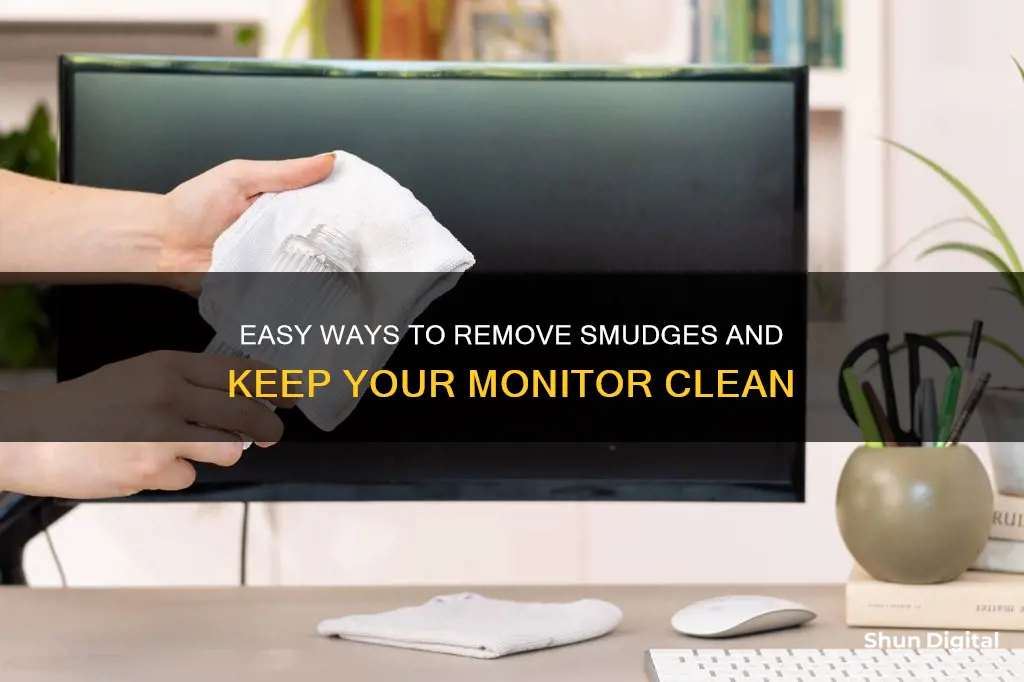
Smudges on your computer screen can be annoying, especially when they keep coming back. Luckily, they are easy to get rid of if you know what you're doing. The oil on our skin, as well as oils and secretions from food, can cause these ugly marks. To remove them, you can use monitor wipes, a soft and silky cloth, or even a clean T-shirt. It's important to be gentle and not push down too hard on the screen, and to only use water or cleaning solutions specifically designed for monitors.

Microfibre cloths
When cleaning your monitor, it is important to use a gentle touch. Avoid pushing down hard on the screen as this can damage the monitor. You should also avoid using anything wet to clean the monitor unless it is specifically designed as a monitor cleaner.
To clean your monitor with a microfibre cloth, start by turning off the monitor and giving it a quick wipe with a dry cloth to remove any dust. Then, if there are any stubborn smudges or fingerprints, lightly dampen a corner of the microfibre cloth with distilled water and gently rub the screen. You can also use a small drop of dish soap mixed with distilled water if the smudges are particularly difficult to remove. Be sure to use a second, dry cloth to remove any soap residue from the screen afterwards.
It is recommended to have multiple microfibre cloths that you can rotate between washes. This is because, once a cloth is full of dust and oils, it becomes less effective for cleaning. You can hand-wash your microfibre cloths in warm water with no detergent and hang them to dry. Avoid using fabric softener, laundry detergent containing fabric softener, bleach, or dryer sheets, as these can coat the cloth and compromise its ability to clean.
Gamer's Guide to Buying the Perfect Monitor
You may want to see also

Monitor wipes
If you're dealing with stubborn marks, you can dampen your cloth with a small amount of distilled water. It's important to avoid using tap water, as this can leave streaks. You can also add a small amount of white vinegar to the water to cut through any built-up grime. However, be cautious when using vinegar, as it can damage anti-glare coatings on certain screens.
When cleaning your monitor, always turn it off and unplug it first. Avoid spraying any liquids directly onto the screen, and never use household cleaning products like window cleaners or ammonia-based solutions, as these can damage the screen's protective coatings.
LCD Monitors: Tubed or Not?
You may want to see also

Scotch tape
To start, take a strip of Scotch tape, preferably the frosty-looking kind, and lay it across the screen. Then, pull the tape up and off the screen. The tape will lift the smudges, oils, and dirt from the screen. Repeat this process as many times as needed to cover the entire surface of the screen.
This method is recommended by several users, who claim it works better and is easier than other methods they have tried. It is also suggested to finish the process by wiping the screen with a microfiber cloth.
Additionally, Scotch tape can be used to remove tape residue from a monitor. If there is tape residue on your monitor, you can use another piece of tape to lift it off. Simply stick the tape onto the residue and lift it off, repeating this process until the residue is gone.
Signs Your LED Monitor is Failing
You may want to see also

Distilled water
Using distilled water is an effective way to remove smudges from your monitor. It is important to remember that you should never spray liquids directly onto the screen. Instead, use a soft, lint-free microfiber cloth and gently wipe the screen in a circular motion. If you are dealing with stubborn marks or smudges, dampen the cloth slightly with distilled water and use light, circular motions when wiping the screen. Avoid applying too much pressure, as this can damage the display.
For tougher stains, you can also create a cleaning solution by mixing distilled water with a small amount of white vinegar or isopropyl alcohol. However, be cautious when using vinegar, as it can damage anti-glare coatings on some screens. Always test any cleaning solution on a small area of the screen first to ensure it does not cause damage.
When cleaning your monitor, it is also important to follow the manufacturer's guidelines and to power off and unplug the monitor before beginning. Regular cleaning will help to prevent buildup and make the process easier.
Removing Delta Monitor Shower Control: A Step-by-Step Guide
You may want to see also

Alcohol and water
Using a mixture of alcohol and water can be an effective way to remove smudges from your monitor. Here is a step-by-step guide on how to do this safely:
Step 1: Power Down and Unplug
Turn off your monitor and unplug the device from its power source. This is important to prevent damage to your screen and to avoid the risk of electrical shock.
Step 2: Prepare the Cleaning Solution
Mix equal parts of 90% rubbing alcohol and water in a small container. The alcohol has cleaning properties, while the water prevents the mixture from drying too quickly and leaving streaks. You can also add a small amount of mild dish soap to the solution if you're dealing with particularly stubborn smudges.
Step 3: Choose the Right Cloth
Select a soft, lint-free microfiber cloth for cleaning. Avoid using paper towels, tissues, or old t-shirts, as these can be too abrasive and scratch your screen. Make sure the cloth is clean and free of any dirt or debris that could damage the monitor.
Step 4: Apply the Solution to the Cloth
Dampen the microfiber cloth with your cleaning solution. Be sure not to oversaturate the cloth, as you don't want excess liquid dripping onto your monitor. You should only need a light application of the solution to effectively remove smudges.
Step 5: Wipe the Screen
Starting at the top of the screen, use gentle, overlapping "Z" strokes or circular motions to wipe the screen with your dampened cloth. Be careful not to press too hard, as this can damage the display. Work your way down to the bottom of the screen, and use a dry section of the cloth to buff away any remaining residue.
Step 6: Let the Screen Dry
Before turning your monitor back on, ensure that it is completely dry. This typically takes around 10-15 minutes. This step is crucial to prevent any potential electrical issues or damage when powering on the device.
Additional Tips:
- Always spray or apply the cleaning solution to the cloth, never directly onto the screen.
- Avoid using tap water if possible, as it may contain minerals and impurities that can leave streaks or residue. Distilled water is the best option.
- Clean your monitor regularly to prevent dust and smudge buildup, making the process easier each time.
- If you have a glass-coated LCD screen (common in many Apple products), you can use a Lysol wipe to disinfect and remove stubborn smudges.
Best Places to Buy Monitor Heaters This Winter
You may want to see also
Frequently asked questions
Use a monitor wipe, a soft cloth, or a clean T-shirt to gently rub the screen.
Yes, but only use distilled water and avoid spraying it directly onto the screen. Instead, spray a small amount onto a cloth and then wipe the screen.
No, it's not recommended. Water might drip inside the panel and cause it to short-circuit when turned back on.
Use a soft, smooth cloth such as a microfiber cloth, or a glasses wipe. Avoid using paper towels or anything abrasive as this can scratch the screen.







